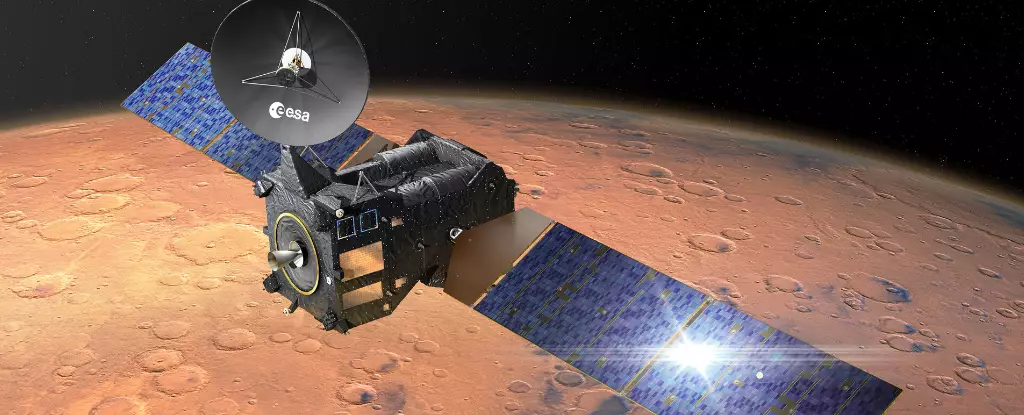In a groundbreaking initiative that seamlessly marries art with science, the European Space Agency’s Exomars Trace Gas Orbiter (TGO) engaged the world in a thrilling project dubbed “A Sign in Space.” Launched in May 2023, TGO sent a simulated extraterrestrial signal to Earth, inviting citizen scientists to decode its potentially cosmic message. This project is not merely an academic exercise; rather, it fosters a communal exploration of our universe, tapping into the creativity and ingenuity of individuals globally.
A significant catalyst for this initiative is the literary inspiration drawn from Italo Calvino’s Cosmicomics. The intertwining of literary creativity with scientific inquiry serves to broaden the audience, reaching not just scientists but also lovers of art and literature. The multifaceted partnership of notable institutions, including the SETI Institute, the Green Bank Observatory, the ESA, and the Istituto Nazionale di Astrofisica (INAF), underscores the collaborative spirit of this endeavor, enriching it with diverse expertise and perspectives.
In an age where enthusiasm for citizen science is flourishing, the response to the decoding challenge was immense. Within ten days, over 5,000 participants worldwide joined forces to analyze the raw data captured from three separate radio astronomy observatories. This unprecedented mobilization not only highlighted an inspiring willingness to engage with scientific exploration but also showcased the power of collective human intelligence. With diverse backgrounds and skill sets, the contributors enriched the process, amplifying the chances of successful decoding.
The father-daughter duo, Ken and Keli Chaffin, emerged as the vanguard of this effort after a year of intricate simulations and relentless work. Their achievement in deciphering the message is emblematic of the project’s collective purpose: showcasing how ordinary individuals can contribute meaningfully to scientific endeavors. The decoding process itself is a testament to teamwork, where thousands of participants worked in harmony to untangle an enigma from the cosmos.
The culmination of the decoding effort revealed an image of five amino acids, illustrated in a retro-futuristic style—the elementary units that constitute life as we know it. This astonishing find, presented by Chaffin, was more than a breakthrough in decoding; it served as a visual manifestation of the potential connections between the cosmos and biology. The encoded message revealed a structure made up of clusters and lattices—a veritable cosmic blueprint hinting at the possibility of life beyond Earth.
In his explanation, Ken Chaffin described the sophisticated techniques he utilized, including reversible cellular automata that join computational methods with the artistry of simulation. This cross-disciplinary approach exemplifies the richness of the project, as science and creativity intertwined during the decoding process. Chaffin’s meticulous attention to detail and engagement with his method resonates with the original intent of broadening participation in scientific discovery.
Now that the initial stages of decoding are complete, the focus shifts toward interpreting the significance of this message. What does it truly represent? Is it a cosmic call for communication, an artistic expression, or perhaps a warning? The possibilities are as vast as the universe itself. The project offers multiple avenues for public engagement, inviting participants to independently analyze the decoded content and contribute their interpretations on the project’s Discord channel.
This phase presents an exciting opportunity for deeper reflection. Interactions among citizen scientists, scholars, and enthusiasts allow for a diverse tapestry of interpretations, enriching the dialogue surrounding humanity’s readiness for potential contact with extraterrestrial life. This project not only inspires collaborative thinking but also challenges us to confront profound questions about our existence and our place in the cosmos.
The ambitious endeavor of “A Sign in Space” represents a pivotal moment in the intersection of art, science, and public engagement. Through this initiative, we are reminded of the limitless potential of human curiosity and collaboration. As we continue to explore the message from the Exomars Trace Gas Orbiter, it is essential to nurture a culture that encourages participation in scientific exploration. The experience gained here lays the groundwork for future projects that may further unravel the mysteries of the universe, fostering a sense of shared discovery and connectedness among humanity.
In this era of rapid advancement, the message from above may serve as a prompt for introspection: Are we prepared to reach out and communicate with potential extraterrestrial civilizations? The endeavor invites us all to contemplate how we might engage with the universe as active participants in its unfolding narrative, guided by creativity, collaboration, and an insatiable thirst for knowledge.


Leave a Reply